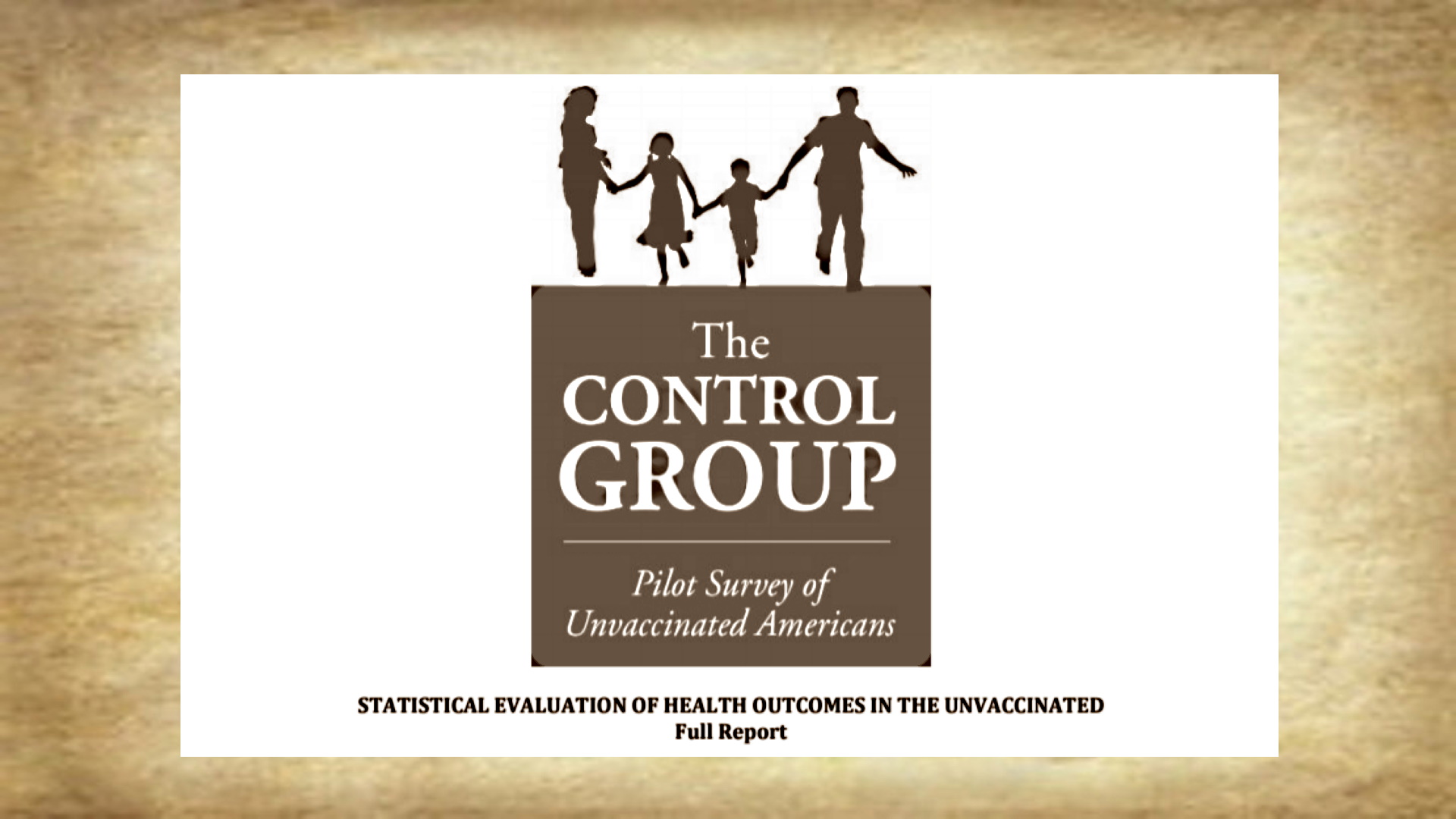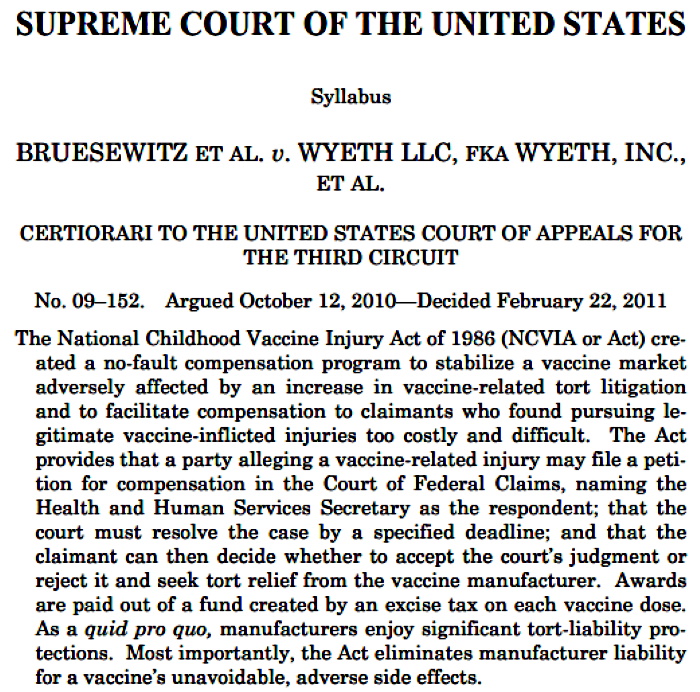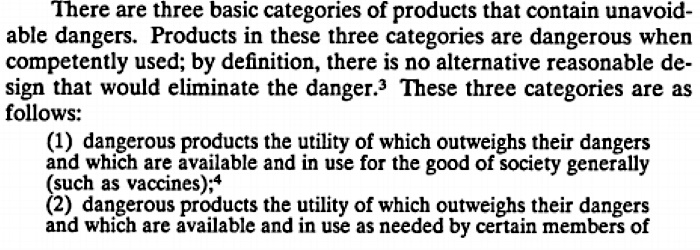
New Survey of Vaccine-Free Group Exposes Long-term Impact of Vaccination Policies on Public Health
by Greg Glaser and Pat O’Connell, Vaxxter
February 22, 2021
They tell us vaccines are “safe and effective.”
They tell us the risks of common diseases outweigh the risks of vaccines.
They tell us vaccine risks are “rare.”
What if none of these claims are true?
In 2019, Joy Garner with The Control Group set out to answer that question by conducting a litigation survey of never-vaccinated people. They found that, in every case, the claims we hear from our vaunted government and TV experts about the risks and benefits of vaccines are demonstrably false.
In fact, they learned that the tiny, vaccine-free minority of Americans is far healthier overall than the vaccinated majority.
But let’s step back for a moment to the questions we should all be asking about those familiar claims.
(Q) Are vaccines safe?
(A) No.
In its 2011 case, Bruesewitz v. Wyeth, the US Supreme Court acknowledged that vaccines cause injuries.
“The National Childhood Vaccine Injury Act of 1986 (NCVIA or Act) created a no-fault compensation program to stabilize a vaccine market adversely affected by an increase in vaccine-related tort litigation and to facilitate compensation to claimants who found pursuing legitimate vaccine-inflicted injuries too costly and difficult.”
The Court noted that vaccine injuries are unavoidable.
“Most importantly, the Act eliminates manufacturer liability for a vaccine’s unavoidable, adverse side effects.”

Justice Scalia noted that the FDA regulations specify no criteria for measuring, much less ensuring, the claimed safety or effectiveness of vaccines.
“Indeed, the FDA has never even spelled out in regulations the criteria it uses to decide whether a vaccine is safe and effective for its intended use.” (Emphasis added.)
To make our answer even clearer, the law classifies vaccines as “unavoidably unsafe products.”
“Unavoidably unsafe products. There are some products which, in the present state of human knowledge, are quite incapable of being made safe for their intended and ordinary use. These are especially common in the field of drugs.”

The excerpt above aptly notes the common and more direct synonym for the word unsafe. That synonym is: dangerous.
Unavoidably dangerous products include motorcycles, parachutes, chainsaws guns …
… and vaccines.
To emphasize the point, the 1986 law gave vaccine makers immunity from legal liability and created a no-fault vaccine court that compensates families for documented vaccine injuries and deaths out of a taxpayer fund.
So the answer to the question “Are vaccines safe?” is a solid and resounding “No.”
We know for a fact vaccines are dangerous. They absolutely cause injuries and deaths. And yet “the authorities” have decided for us that the benefits outweigh the risks. What is that decision based on?
(Q) Do the risks of common diseases outweigh the risks of vaccines?
(A) We don’t know.
That’s right: We. Don’t. Know.
Why we don’t know is a long story. But the key reasons are these:
- The real risks of common, short-term, vaccine-targeted diseases are routinely exaggerated, and the truth about those risks is suppressed by the authorities and the media. One recent report on changes to the vaccine court’s injury table from the US Department of Health and Humans Services (HHS) repeats empty claims of vaccine benefit and discounts the scope and severity of vaccine harms without a shred of proof.
- The benefits of common diseases are rarely, if ever, acknowledged by the authorities. (Yes there are benefits of getting diseases, including reduction in the risks of more serious illnesses like shingles and certain cancers.)
- Emergency vaccines (like those for covid-19) may not be properly tested in animals before being approved for Phase 1 human trials. Animal trials are crucial to determine how vaccinated subjects react later, when they are exposed to the wild virus, to ensure they don’t create pathogenic priming, which can trigger a dangerous, sometimes deadly, immune overreaction called a “cytokine storm.”
- Vaccines are not safety tested against harmless (inert) placebos like saline. They’re tested against false “placebos” consisting of other unavoidably unsafe vaccines already on the market or the most toxic ingredients in the new vaccine. That’s why we never know how vaccines stack up against Nature, or random chance. Similarly, vaccine clinical trials never use fully unvaccinated control subjects. This is like a tobacco company claiming cigarettes are safe because they compared people who smoke 70 cigarettes per week to those who smoke 69 cigarettes per week.
- The authorities have never systematically and broadly compared the long-term health of the vaccine-free who have caught these infections versus the health of those who have been vaccinated for the diseases.
Despite what we’re told, we simply can’t know whether getting common infections is more dangerous than getting vaccinations for them without studying the health outcomes of both vaccinated and unvaccinated subjects.
(Q) Are the risks of vaccines “rare”?
(A) We don’t know.
Again, there’s something vitally important we don’t know about a widely and coercively used class of product.
And again, it’s a long story.
There are many reasons we don’t know how “rare” (or common) vaccine injuries and deaths are. They include these:
- The national Vaccine Adverse Events Reporting System (VAERS) captures fewer than 1% of all vaccine reactions and deaths according to the government’s own study by Harvard Pilgrim Health Care. In other words, the system misses more than 99% of harms caused by vaccines. That means any statistics showing the number of adverse reactions must be multiplied by 100 for a reasonably accurate estimate.
(To be clear: injuries and deaths occurring after vaccines are not necessarily caused by the vaccines. Correlation does not equal causation. But when associations stretch the bounds of coincidence to the breaking point, we are obligated to look deeper for possible connections.)
- And there is no system that tracks long-term vaccine consequences that only emerge after months or years of immune overstimulation by vaccine toxins that can’t be easily purged from the body.
- In three separate reviews of the best available science on claimed vaccine harms, the government’s Institute of Medicine (IOM) found the majority (as high as 85%) of studies were “inadequate” to either prove or disprove causation. This means the studies were so poorly designed and/or executed they can’t prove anything, one way or the other.
- The entire vaccine schedule and the specific combinations of vaccines that children are routinely given at one time have never been studied for interactive or cumulative harms.
- The authorities have never systematically and broadly compared the overall health of the vaccinated to that of vaccine-free populations.
- Our healthcare providers are taught, perhaps pressured, to see even distressing vaccine reactions as “normal,” and to categorize diseases and disorders that arise weeks, months or years after vaccination as “unrelated coincidences.” They may indeed see and worry about the declining health among patients, but never connect those declines with vaccines because the evidence that might connect them is lacking, inadequate or suppressed.
“Rare” can only be judged in relation to something else. In the case of vaccine harms, we need a substantial group of vaccine-free citizens and a clear accounting of their health issues to compare the relative “rarity” (or frequency) of harms in people who get vaccines to the frequency of such harms in people who don’t.
This reference population exists for moment, though their numbers are falling. And our esteemed authorities steadfastly refuse to study them.
That’s why the answer to question three, “Are vaccine risks rare?” is also “We don’t know.”
The Looming Extinction of Our Endangered Vaccine-Free Population
Joy Garner realized that the most important group of people in America was being driven toward extinction by ever more forceful vaccine mandates, dwindling exemptions, and blatant coercion.
Her survey group represents the desperately needed “control group” for this massive experiment our authorities have been conducting on our children, and increasingly on adults, for at least 30 years now. Only the never-vaccinated among us can show us what life and health look like when we let our immune systems do their jobs and manage illnesses as they come along.
The vast majority of Americans—99.97%, or more than 329 million—have been exposed to vaccines.
By contrast, our tiny group of vaccine-free citizens makes up only about 0.26% of the population, or roughly 800,000 children and adults.
Yet, curiously, they are often feared and blamed for all the ills of the majority. Do the healthy, unvaccinated few among us really have that much power?
Garner saw the decline of the unvaccinated control population and knew it was vitally important to gather the wisdom manifested in their health trajectories while it was still possible. And it was important to protect this endangered species from extinction.
The Control Group Survey
Garner named her litigation The Control Group for obvious reasons. Her passion and love for others drove her to tackle this project our authorities should have done, and still should do on a larger scale.
But it was her intelligence and business experience that gave her the skills and confidence to pull it off.
After all, at its core, the task was straightforward:
- Create a survey like the ones the authorities typically use to gather health data on Americans.
- Get the survey into the hands of the target population (the never-vaccinated).
- Crunch the numbers from the surveys, and validate the results.
- Compare health outcomes from the survey results to national health statistics for the vaccinated majority.
The survey instruments themselves were streamlined into two forms, and the process followed appropriate protocols for collecting and reporting health data for litigation. The forms prompted respondents to report all illnesses and disabilities.
Garner reached the subject population by promoting the survey through social media, radio interviews, events, referrals and other means.
Surveys were manually completed and mailed back (or handed back at events) to help eliminate some of the flaws in online, electronic surveys.
Follow-up calls clarified unclear answers and helped ensure participants recalled and reported all health issues.
Garner compiled and evaluated the results using established statistical practices, and engaged experts in relevant fields to validate the forms and the process as well as the results.
And she acquired comparable statistics for the vaccination population from national health reports.
In the end, survey respondents represented a solid 0.179% of the entire vaccine-free population, estimated during the survey period at around 832,521 Americans, and ranged in age from under 1 year to 73.
From the data on both groups—the vaccinated and the never-vaccinated—her team generated graphs that tell a powerful story, one every American, indeed, every citizen of the world, should hear. Now. While they still can.
Go to VAXXTER to read full article
Greg Glaser is a health freedom lawyer in California.
Pat O’Connell is a health freedom advocate in Texas.
STATISTICAL EVALUATION OF HEALTH OUTCOMES IN THE UNVACCINATED Full Report PDF
2020 Pilot Survey Data Comparison VACCINATED -VS- UNVACCINATED Graphs PDF

Truth Comes to Light highlights writers and video creators who ask the difficult questions while sharing their unique insights and visions.
Everything posted on this site is done in the spirit of conversation. Please do your own research and trust yourself when reading and giving consideration to anything that appears here or anywhere else.










